Introduction
The effectiveness of customer acquisition strategies will determine an organisation's success. Inefficiencies in customer acquisition strategies can lead to lost revenue, lower customer retention rates, and weakened competitive positions. If customer acquisition strategies remain ineffective, businesses face decreased market share, reduced profitability, and potentially business failure.
This underlines the urgency and necessity of adopting appropriate tools which can address specific industry requirements and consumer behaviour dynamics. The discussed tools and strategies are not only instrumental in optimising customer acquisition but are also vital in maintaining a sustainable competitive edge in rapidly changing markets.
Business Domain and Problem Analysis
Business Development is focused on the creation of long-term value for an organisation through customers, markets, and relationships. Within this broad field, enhancing the effectiveness of customer acquisition strategies is paramount. Optimal customer acquisition enhances market share, revenue, and overall business growth.
Problem Specifics: The current customer acquisition strategies exhibit inefficiencies. These could stem from improper market segmentation, poor competitive positioning, ineffective marketing mix deployment, or lack of insightful feedback from existing customers. Addressing these issues will require a comprehensive review and overhauling of current strategies, redefinition of customer metrics, and potentially reorientation towards different, more lucrative market segments or verticals.
Toolkit Selection Method
Evaluating Problem Requirements
For a business facing ineffectiveness in its customer acquisition strategies, key needs and challenges typically include:
- Understanding of Competitive Environment: Recognising barriers to entry and evaluating competitor strategies.
- Market Segmentation: Identifying precisely who the customers are and tailoring strategies to these segments.
- Customer Insights: Gathering and analysing customer feedback to refine offerings.
- Optimisation of Marketing Strategies: Reviewing and redefining the 4Ps to align with customer expectations and competitive dynamics.
- Measurement and Adaptation: Establishing metrics to measure the success of acquisition strategies and iteratively improving these strategies based on data.
Selecting the Toolkit Tools
Strategic Description Tools
- Porter's Five Forces & SWOT Analysis: These tools will assess the competitive dynamics and the internal strengths and weaknesses of the company's current strategies. This foundation helps in identifying both the challenges and the opportunities the company can leverage to enhance its acquisition efforts.
- Customer Segmentation & Journey Mapping: By segmenting the customers and mapping their journeys, the company can unveil specific pain points and high-impact touch points that possibly contribute to the ineffectiveness of current strategies.
- Voice of the Customer (VoC): Direct insights from customers can help refine the understanding of customer needs and how well they perceive the value proposition offered by the company.
Strategic Planning Tools
- Positioning Map & Marketing Mix (4Ps): These tools are crucial for redefining the company’s value offering and how it is communicated and delivered to the target segments. They ensure that product, price, place, and promotion are optimally aligned with market requirements.
- Blue Ocean Strategy: This strategy could guide the business to explore new, uncontested markets, thereby reducing competitive pressures and focusing on growth through innovation.
- AARRR Metrics & Customer Lifetime Value (CLV): Metrics like AARRR provide a broad but detailed view of customer engagement from acquisition to revenue, helping to identify effective strategies and areas for improvement. CLV calculations assist in prioritising marketing efforts based on potential revenue streams over customer relationships.
Strategic Execution Tools
- Balanced Scorecard & OKRs: These provide frameworks for making strategic decisions based on data and monitoring the outcomes of strategic initiatives across various dimensions of the business.
- Agile Marketing & Growth Hacking: Implementing these adaptive approaches ensures that the marketing strategies are responsive to changes in market dynamics and customer preferences and can scale effectively.
- Marketing Automation: This enhances efficiency and consistency in customer engagement, ensuring that strategic changes in customer acquisition are effectively implemented without losing personal touch with the customer base.
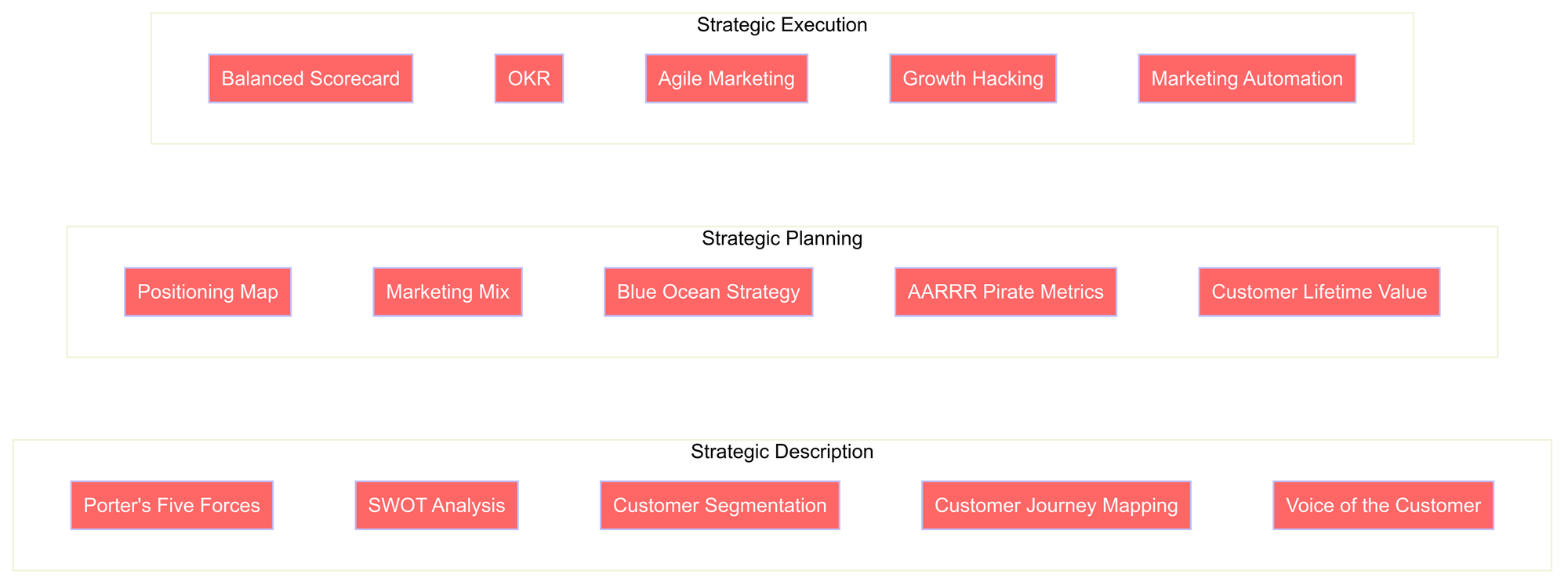
The combination of strategic description, planning, and execution tools in the Management Consultant Toolkit presents a robust foundation for addressing the ineffective customer acquisition strategies identified.
By applying these tools, the business can undertake a comprehensive review and revamp of its strategies, focusing on data-driven decisions, and customer insights which are essential for success in business development.
By leveraging these strategy formulation and execution frameworks, the business is well-equipped to overcome its current challenges and improve its trajectory towards effective customer acquisition and sustained growth.
Enhancing the Toolkit - Industry Specific Auxiliary Tools
In Business Development, the effectiveness of customer acquisition strategies is pivotal for sustained growth and competitive advantage. While the Management Consultant Toolkit provides a comprehensive approach to addressing these challenges holistically, the integration of industry-specific auxiliary tools can offer tailored insights and solutions that align with unique sectoral dynamics.
Primary Sector: Agriculture, Mining, Forestry, and Fishing
- Address variability in market demands.
- Manage resource-intensive production efficiently.
- Navigate regulatory and environmental challenges.
PESTEL Analysis: Enhances understanding of macro-environmental impacts on agriculture and mining, complementing Porter's Five Forces by providing a broader external perspective.
Porter's Diamond: Offers insights into competitive advantages specific to nations, facilitating better strategic positioning globally.
Precision Agriculture and Closed-Loop Supply Chain: These tools modernise the execution frameworks like Marketing Automation and the Balanced Scorecard, focusing on sustainability and efficiency—key concerns in resource-dependent industries.
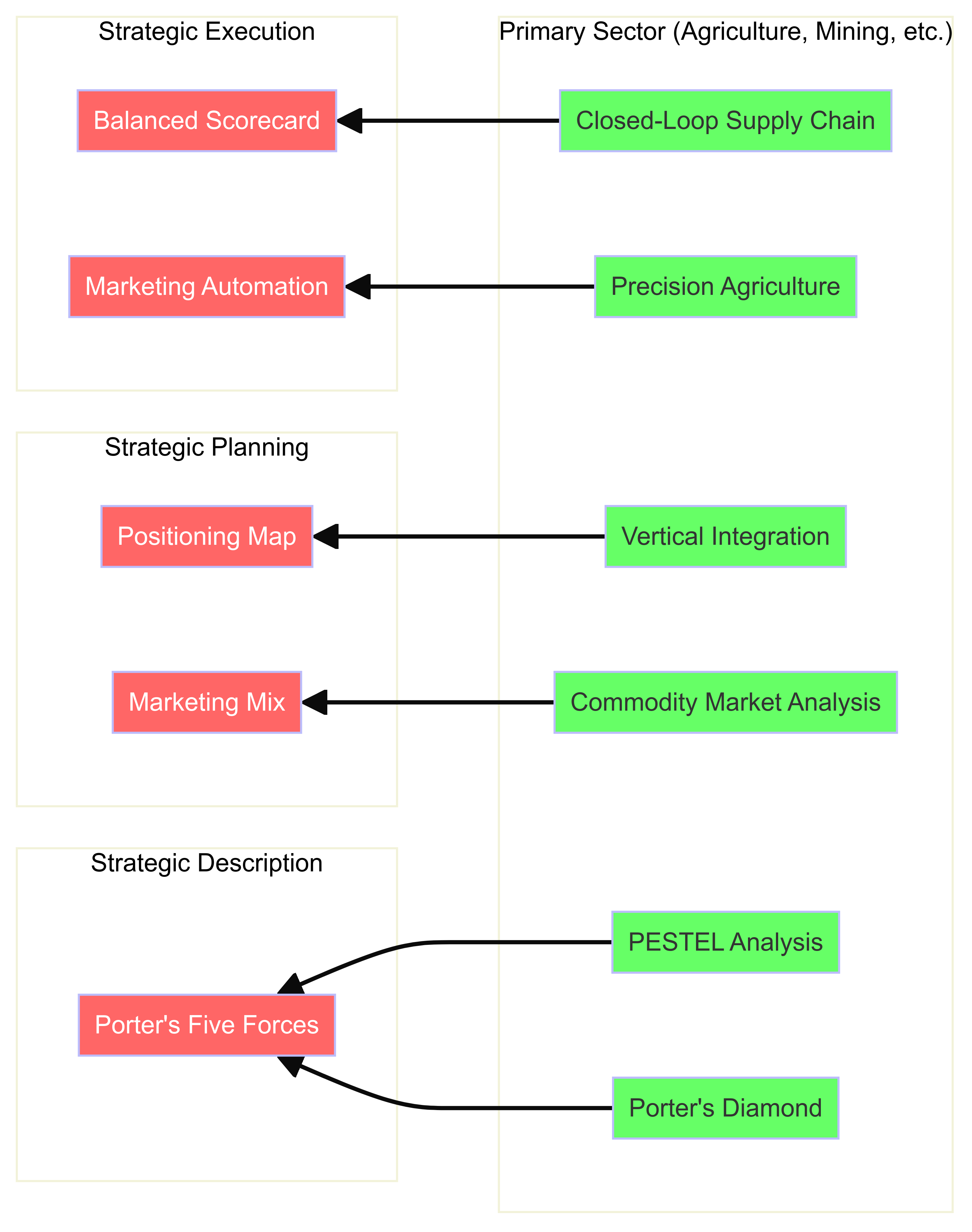
Secondary Sector: Manufacturing and Construction
- Optimise production processes.
- Enhance product quality and customisation.
- Reduce manufacturing costs and inefficiencies.
Value Chain Analysis: Integrates directly with Porter's Five Forces to enhance competitive strategy through detailed assessment of production activities.
Theory of Constraints (TOC) and Lean Manufacturing: These methodologies refine the strategic execution by pinpointing and alleviating workflow bottlenecks, directly enhancing efficiency metrics in Balanced Scorecards and OKRs.

Tertiary Sector: Services
- Improve service quality and customer satisfaction.
- Enhance customer-service interaction.
- Innovate service delivery methods.
Service Blueprinting: Complements Customer Journey Mapping by detailing all service interaction points, allowing for strategic improvements in customer engagement.
Experience Economy and Servitisation: These strategies provide a foundation for transforming product-centric approaches into service-dominant logic, aligning with Marketing Mix adaptations to better meet consumer expectations.

Quaternary Sector: Information Technology and Knowledge Services
- Adapt to rapid technological changes.
- Manage innovation lifecycle.
- Capture diverse market segments effectively.
Technology Adoption Lifecycle: Tailors Customer Segmentation strategies by identifying how different groups adopt technology, thereby facilitating more focused marketing strategies.
Open Innovation and Design Sprints: Elevate strategic planning and execution by incorporating external innovations fast and iterating product features, which are critical for maintaining competitive advantage in fast-paced tech landscapes.
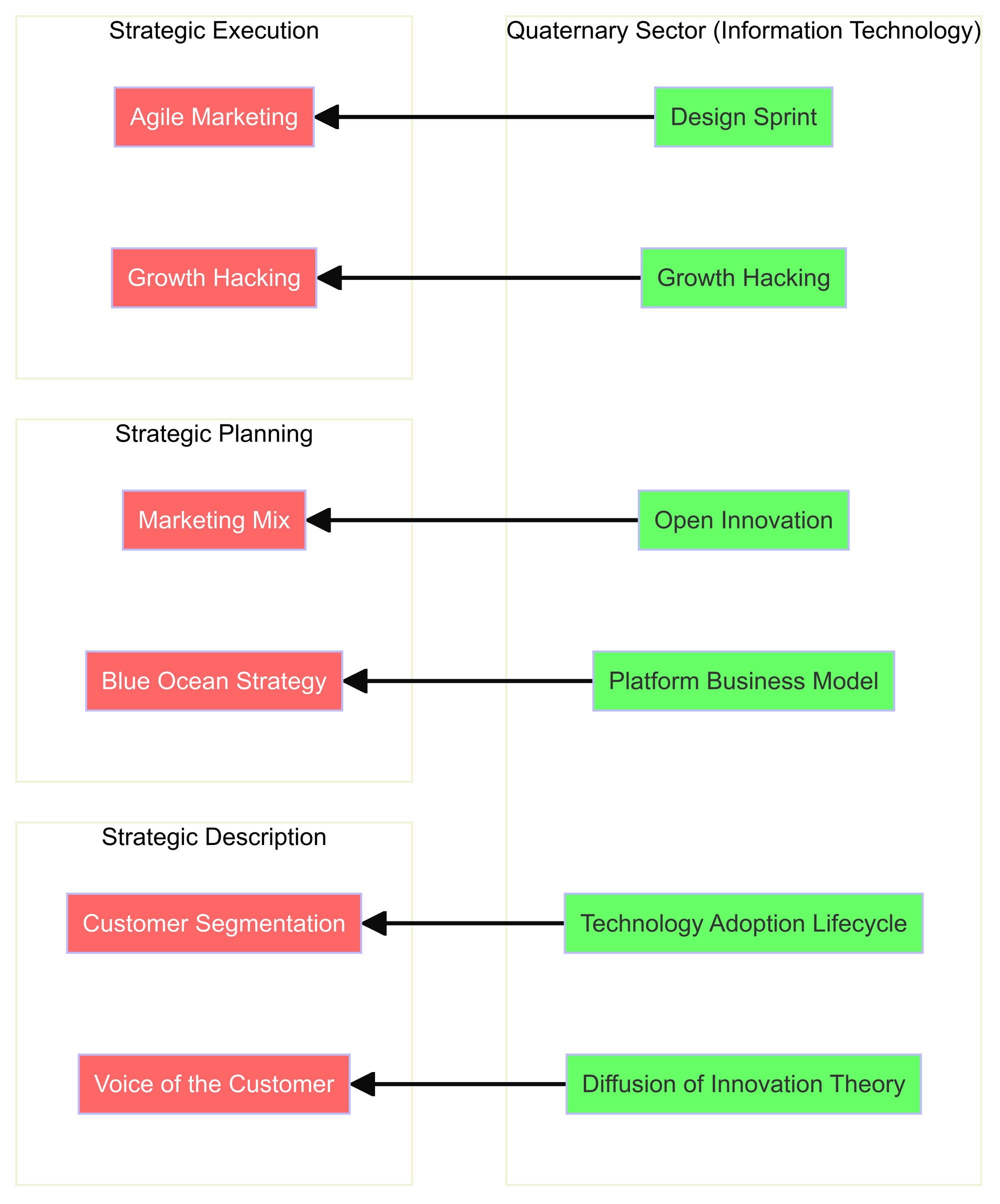
Quinary Sector: Knowledge-Based Industries
- Manage intellectual property strategically.
- Foster innovation and knowledge sharing.
- Leverage academic and governmental partnerships.
Intellectual Capital Assessment and Intellectual Property Strategy: These tools enhance the SWOT Analysis and Positioning Map by ensuring that intangible assets are adequately recognised and leveraged for competitive advantage.
Communities of Practice and Innovation Labs: These execution tools focus on the agile development of new ideas and solutions, supporting continuous learning and improvement cycles crucial in knowledge-driven industries.
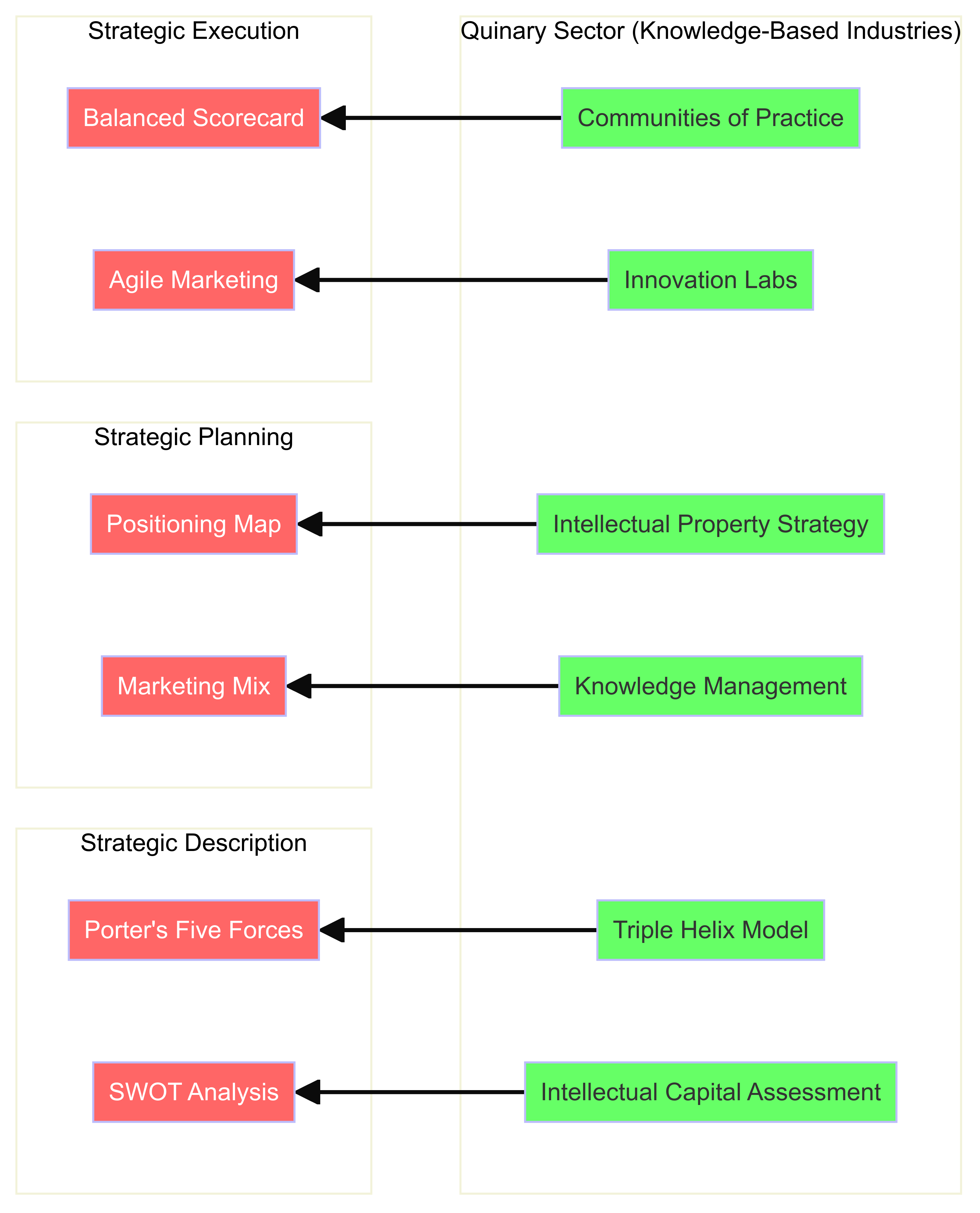
With the integration of industry-specific auxiliary tools with the Management Consultant Toolkit not only addresses the uniqueness of each sector but also enhances the customisation of strategies to improve customer acquisition effectiveness.
By tailoring approaches to the inherent challenges and dynamics of each industry, businesses can leverage these comprehensive strategies to achieve superior market penetration and sustainable growth.
This multifaceted approach ensures that strategies are not only theoretically sound but pragmatically effective, catering to the nuanced needs of diverse business landscapes.
Use Cases & Scenario Approach Strategies
The following use cases present methods to utilise the toolkit in specific industry sectors. Each use case will be a version of the problem within a specific industry sector. Each use case will approached as a real-world issue and then explained with a use case narrative to highlight important points or interactions.
Primary Sector Use Case - Agri-Boost Solutions
Organisation Description: Agri-Boost Solutions is a primary sector organisation specialising in the production and distribution of niche agricultural produce. The company operates in a competitive market, supplying high-quality, sustainably grown crops to a discerning clientele. Despite its strong market presence, Agri-Boost Solutions faces challenges in effectively acquiring and retaining customers.
Unique Problem Faced: Agri-Boost Solutions' customer acquisition strategies lack effectiveness, resulting in missed opportunities and stagnant growth. The organisation struggles to identify and target the most profitable customer segments, and its marketing efforts often fail to resonate with potential customers. Additionally, the company has limited insights into the customer journey, making it difficult to optimise touch points and improve the overall customer experience.
- CEO - Jane Doe: Jane is responsible for the overall strategic direction and financial health of Agri-Boost Solutions. She is keen to address the customer acquisition challenges and seeks to implement data-driven, targeted marketing strategies to improve customer engagement and loyalty.
- COO - John Smith: John oversees the day-to-day operations of Agri-Boost Solutions, ensuring efficient production and distribution processes. He is interested in understanding how the organisation can better integrate its operations with its marketing efforts to create a seamless customer experience.
- Marketing Director - Sarah Lee: Sarah leads the marketing team at Agri-Boost Solutions and is responsible for developing and executing marketing strategies. She is eager to leverage new tools and techniques to optimise customer acquisition and enhance the company's market position.
- CRM Manager - Michael Chen: Michael manages the customer relationship management (CRM) system at Agri-Boost Solutions, responsible for maintaining customer data and analysing customer insights. He aims to improve the company's understanding of customer needs and preferences to inform marketing and sales efforts.
- Agricultural Engineer - Emily Wang: Emily is an agricultural engineer responsible for optimising crop yields and resource management using precision agriculture technologies. She is keen to explore how these technologies can be leveraged to enhance customer engagement and improve the customer experience.
- Supply Chain Manager - David Kim: David manages the supply chain at Agri-Boost Solutions, ensuring the timely delivery of products to customers. He is interested in implementing a closed-loop supply chain approach to minimise waste and resource consumption, ultimately contributing to the company's sustainability goals.
Use Case Approach Strategy
Agri-Boost Solutions, operating in the primary sector of agriculture, aims to refine its customer acquisition strategies and enhance overall customer satisfaction. Recognising the ineffectiveness of current approaches directed at customer acquisition and retention, a strategy focused on targeted marketing along with refined operational integrations is required. Such a strategy should better resonate with distinct customer segments, optimise their journey, and ultimately, generate sustained growth for the business.
- Using Data Analytics: Collate and utilise existing customer data to understand differing customer demographics and needs
- Integrated Marketing and Communication Campaigns: Creating a suite of targeted marketing strategies integrated with robust feedback mechanisms to ensure agility and responsiveness
- Operational Alignment with Customer-Focused Initiatives: Assessing each operation for opportunities to enhance customer engagement.
Toolkit Application Roadmap
Solving the problem of ineffective customer acquisition strategies while focusing on leveraging customer segmentation and engagement for strategic outcomes, our toolkit application roadmap will utilise the three primary phases: Strategy Development, Planning, and Execution.
Strategy Development
- Porter's Five Forces & SWOT Analysis: Initially, these tools can provide insights into competitive dynamics and internal capabilities. The insights guide subsequent steps.
- Customer Segregation and Voice of the Customer (VoC): Following the market analysis, these tools will help in gathering and analysing specific information about potential customer segments and their needs.
Strategic Planning
- Positioning Map & Marketing Mix (4Ps): These tools will guide the effective placement of products in the market, ensuring that marketing efforts are directed toward identified customer groups with precision.
- Blue Ocean Strategy: To tap into unexplored customer segments or create new market spaces ensuring reduced competition.
Strategic Execution
- Balanced Scorecard & OKR: These performance measurement tools will track the success of the execution of the strategies and offer data for iterations.
- Agile Marketing & Marketing Automation: Utilise these for real-time modifications in strategies based on performance data thus enabling flexibility and efficiency.
RACI
The RACI table will clarify roles and responsibilities when using the toolkits.
| Tool | CEO (Jane Doe) | COO (John Smith) | Marketing Director (Sarah Lee) | CRM Manager (Michael Chen) | Agricultural Engineer (Emily Wang) | Supply Chain Manager (David Kim) |
|---|---|---|---|---|---|---|
| Porter's Five Forces | C | A | I | R | I | I |
| SWOT Analysis | A | I | R | C | C | C |
| Customer Segmentation | I | C | A | R | C | C |
| Customer Journey Mapping | I | I | A | R | R | I |
| VoC | R | R | R | A | C | C |
| Marketing Mix (4Ps) | C | R | A | R | C | R |
- Responsible (R): Directly involved in the operation/execution of the tool.
- Accountable (A): Ultimately accountable for the successful execution and decision-maker.
- Consulted (C): Whose inputs are sought as subject-matter experts.
- Informed (I): Kept updated about progress and outcomes.
MECE Principle
Every element within the toolkit is mutually exclusive (MECE principle), ensuring no overlapping competencies yet comprehensively covering all areas required to address Agri-Boost Solutions' problem from Strategic Development to Execution. This structured, non-overlapping yet collectively exhaustive approach guarantees no critical facet is overlooked, and duplication of efforts is minimised.
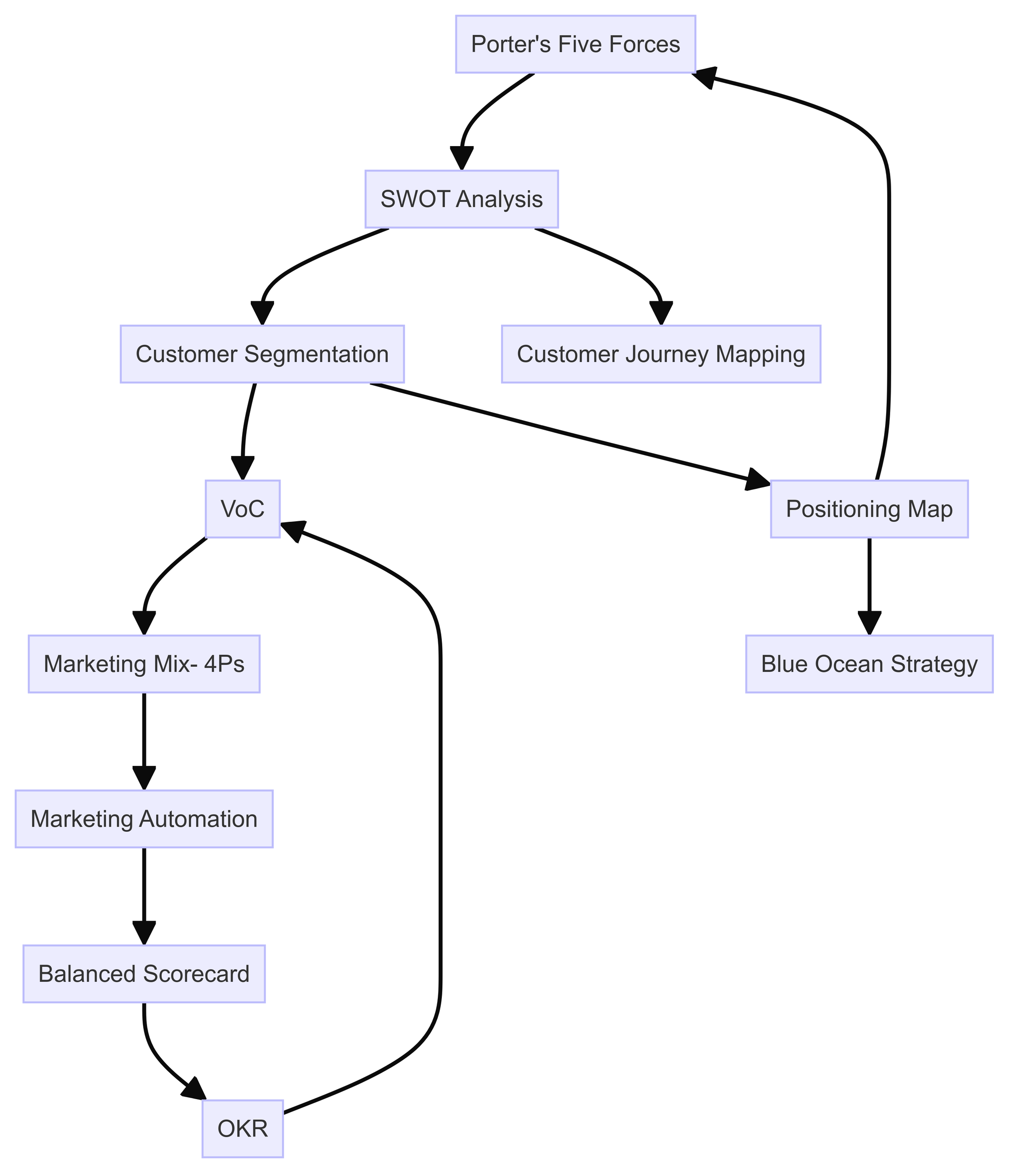
Wrapping it up, Agri-Boost Solutions can leverage this intricate deployment of various tools within their operational framework and marketing strategy to enhance the effectiveness of customer acquisition tactics, by targeting well-segmented customer groups with a more personalised, data-driven approach. This, coupled with actionable insights gained from the implementation of the toolkit, is poised to power a new phase of growth and customer satisfaction for the company.
Use Case Narrative
Agri-Boost Solutions has embarked on a mission to redefine its approach to customer acquisition and satisfaction. The detailed sequence diagram and narrative below outline each phase of their strategic efforts, from initial planning through execution to the final reviews. This process is facilitated by effective communication among key company stakeholders and the use of advanced analytical tools.
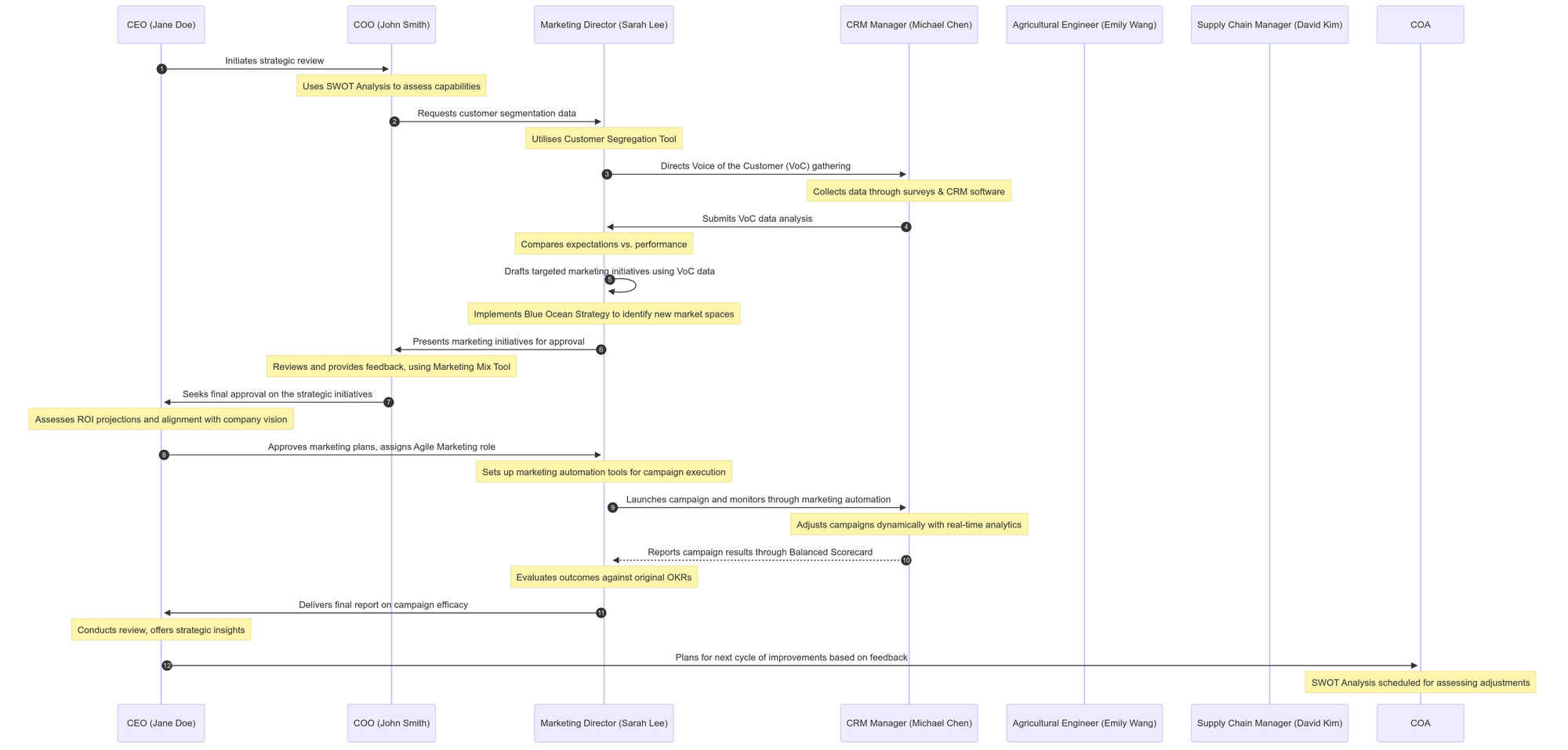
Initial Planning (steps 1-2)
CEO (Jane Doe) initiates a strategic review due to recognised inefficiencies in current approaches. The CEO's leadership is pivotal in setting the tone and direction for the strategy (1). COO (John Smith) is tasked with conducting a preliminary SWOT analysis to evaluate the internal and external factors that could impact the proposed strategies (2).
SWOT Analysis helps in understanding strengths, weaknesses, opportunities, and threats, providing a grounding framework that supports decision-making.
Data Gathering and Analysis (steps 3-4)
Marketing Director (Sarah Lee) receives instructions to collate data that delineates customer demographics and segments, vital for the targeted marketing plans (3). CRM Manager (Michael Chen) is responsible for gathering and analysing VoC data. This involves directly engaging with both existing and potential customers to gather qualitative and quantitative feedback (4).
Customer Segregation and Voice of the Customer (VoC) tools ensure data is reflective of actual customer expectations and experiences.
Planning and Approval (steps 5-7)
Marketing Director drafts viable marketing initiatives shaped by customer data and insights. This involves creative processes that leverage identified unique market positions through a 'Blue Ocean Strategy' (5-6). Marketing Director seeks approval from the COO who uses a Marketing Mix Tool to ensure all four aspects of marketing (product, price, place, promotion) are optimally aligned (6).
Blue Ocean Strategy and Marketing Mix (4Ps) provide a structured approach to exploring new markets and aligning products accordingly.
Execution (steps 8-10)
Marketing Director, upon receiving approvals, implements the marketing plans using Agile Marketing methodologies (7). CRM Manager takes an active role in deploying and tweaking marketing campaigns through automation tools, ensuring strategies remain flexible and data-driven (8).
Marketing Automation facilitates real-time adjustments in the marketing strategy based on ongoing campaign analytics.
Review and Adjustment (steps 11-13)
Marketing Director and CRM manager regularly evaluate the performance against objectives using Balanced Scorecard and OKRs. This provides a systematic approach to measuring success and areas needing adjustments (9). CEO reviews the campaign's impact, informs the board, and discusses future strategic initiatives based on the gathered insights (10-12).
Balanced Scorecard and OKRs measure strategic performance and help in setting quantifiable objectives for future marketing initiatives.
By methodically following each step and leveraging specific tools for different phases of customer engagement and strategy execution, Agri-Boost Solutions enhances its approach to customer acquisition and experience. Continuous feedback mechanisms are integrated at every stage to ensure the strategy remains adaptable and aligned with real-time market conditions and customer feedback. This approach not only strengthens Agri-Boost's market position but also ensures sustained business growth and customer satisfaction.
Secondary Sector Use Case - ManuTech Solutions
Organisation Description: ManuTech Solutions is a fictional organisation specialising in providing business development and customer acquisition strategy consulting services to companies in the secondary sector, specifically focusing on manufacturing industries. They help clients identify ineffective customer acquisition strategies, analyse competitive environments, and develop tailored plans to optimise customer acquisition and improve overall business performance.
Unique Problem Faced: ManuTech Solutions has identified that their manufacturing clients often struggle with customer acquisition due to the rapid evolution of technology and increasing competition. Traditional customer acquisition strategies are no longer effective, and companies need to adapt to new market trends and customer expectations to remain competitive.
- CEO - Jane Doe: As the Chief Executive Officer, Jane is responsible for setting the overall vision and strategy for ManuTech Solutions. She works closely with the management team to ensure that the organisation stays at the forefront of industry trends and provides the best possible services to its clients.
- COO - John Smith: As the Chief Operating Officer, John oversees the day-to-day operations of ManuTech Solutions and ensures that the organisation's consulting projects are executed efficiently and effectively. He collaborates with the management team to develop and implement internal processes and tools that enable consultants to deliver high-quality services to clients.
- Senior Consultant - Alex Johnson: As a Senior Consultant, Alex leads client engagement teams and works directly with manufacturing companies to diagnose customer acquisition strategy ineffectiveness and develop tailored solutions. Alex leverages tools such as Porter's Five Forces, SWOT Analysis, and Customer Segmentation to provide actionable insights and recommendations.
- Business Development Manager - Sarah Lee: As the Business Development Manager, Sarah is responsible for identifying new business opportunities and building relationships with potential clients in the manufacturing sector. She collaborates with the management team to develop marketing strategies and sales plans that position ManuTech Solutions as a thought leader and trusted advisor in the industry.
- Data Analyst - Michael Chen: As a Data Analyst, Michael supports the consulting team by gathering and analysing data related to customer acquisition, competitive environments, and market trends. He uses tools such as PESTEL Analysis, Commodity Market Analysis, and Technology Adoption Lifecycle to provide data-driven insights that inform consulting recommendations.# Use Case Scenario Approach Strategy
Use Case Approach Strategy
ManuTech Solutions, a leading consulting firm within the manufacturing sector, encounters a pressing issue with their clients' customer acquisition strategies rendered ineffective due to rapid technological changes and increasing competition.
To address this, a comprehensive strategy using a specifically designed toolkit tailored for the manufacturing industry is necessary. Below is a strategic approach detailing how to leverage the provided toolkit to optimise customer acquisition and stay competitive.
Toolkit Application Roadmap
Strategy Development
The initial phase involves deep analytical tools to understand both the internal and external business environment:
- Porter's Five Forces & Value Chain Analysis: Together, these tools will shed light on the competitive setting and key value-driving activities, alongside potential barriers to entry which directly influence customer acquisition strategies.
- SWOT Analysis: Will help pinpoint internal strengths and weaknesses, and external opportunities and threats relevant to the market dynamics.
- Customer Segmentation & Quality Function Deployment (QFD): These will be used to categorise customers based on various attributes and directly translate their needs into design and production specifications—a crucial step for tailored customer acquisition.
Strategic Planning
In the planning phase, focus shifts to strategising based on the insights gained:
- Marketing Mix & Design for X (DFX): Ensuring that the Product, Price, Place, and Promotion strategies are ideally suited to manufacturing needs while optimising product design for superior market competitiveness.
- Theory of Constraints (TOC) & Blue Ocean Strategy: These methods will identify and mitigate bottlenecks while establishing undisputed market spaces, respectively—crucial for effective maneuvering in saturated markets.
Strategic Execution
Execution tools are necessary to implement the strategies devised:
- Lean Manufacturing & Six Sigma: To apply continuous improvement principles and data-driven methodologies for reducing defects and enhancing customer service.
- Agile Marketing & Growth Hacking: Enabling rapid, iterative campaign development and innovative, cost-effective marketing strategies to boost customer acquisition.
Phase 1: Analysis: Deploy Porter's Five Forces, SWOT Analysis, and Value Chain Analysis to understand the competitive landscape and internal capabilities.
Phase 2: Customer Insight: Utilise Customer Segmentation and QFD to derive precise customer profiles and needs.
Phase 3: Strategic Framework Development: Formulate strategies using Marketing Mix, DFX, TOC, and Blue Ocean Strategy.
Phase 4: Implementation & Optimisation: Implement strategies using Lean Manufacturing, Six Sigma, Agile Marketing, and Growth Hacking.
Phase 5: Monitoring & Evaluation: Regularly review strategy efficacy using tools like Marketing Automation and Customer Lifetime Value calculations.
RACI
The RACI table will clarify roles and responsibilities when using the toolkits.
- CEO: Focuses on strategic oversight, ensuring alignment with the company's long-term goals.
- COO: Manages operational implementation and efficiency of process-oriented tasks.
- Senior Consultant: Leads most analytical and strategic development tasks.
- Business Development Manager: Spearheads initiatives that directly affect marketing and customer outreach.
- Data Analyst: Supports with data essential for making informed decisions.
| Task/Tool | CEO (Jane Doe) | COO (John Smith) | Senior Consultant (Alex Johnson) | Business Dev Manager (Sarah Lee) | Data Analyst (Michael Chen) |
|---|---|---|---|---|---|
| Porter's Five Forces | Consult | Inform | Lead | - | - |
| SWOT Analysis | Accountable | Inform | Lead | - | - |
| Marketing Mix | - | Accountable | Support | Lead | Support |
| Lean Manufacturing | - | Accountable | Lead | - | Support |
| Growth Hacking | - | Inform | Support | Lead | Support |
- Responsible (R): Directly involved in the operation/execution of the tool.
- Accountable (A): Ultimately accountable for the successful execution and decision-maker.
- Consulted (C): Whose inputs are sought as subject-matter experts.
- Informed (I): Kept updated about progress and outcomes.
MECE Principle
Throughout this use case scenario, the MECE principle (Mutually Exclusive, Collectively Exhaustive) is adhered to by ensuring that each tool tackles a specific, unique aspect of the problem without overlap, while collectively they provide a comprehensive approach to addressing the client's customer acquisition challenges.

This structured and systematic method not only facilitates clarity and effectiveness in strategy development and execution but also ensures that all potential aspects of the problem are covered, making the strategy robust and resilient in dynamic market conditions.
Use Case Narrative
Within the manufacturing sector, effective customer acquisition strategies are vital for sustaining competitiveness. ManuTech Solutions has developed a meticulous approach to revamping these strategies by integrating a uniquely tailored toolkit catering expressly to the industry's dynamic needs.
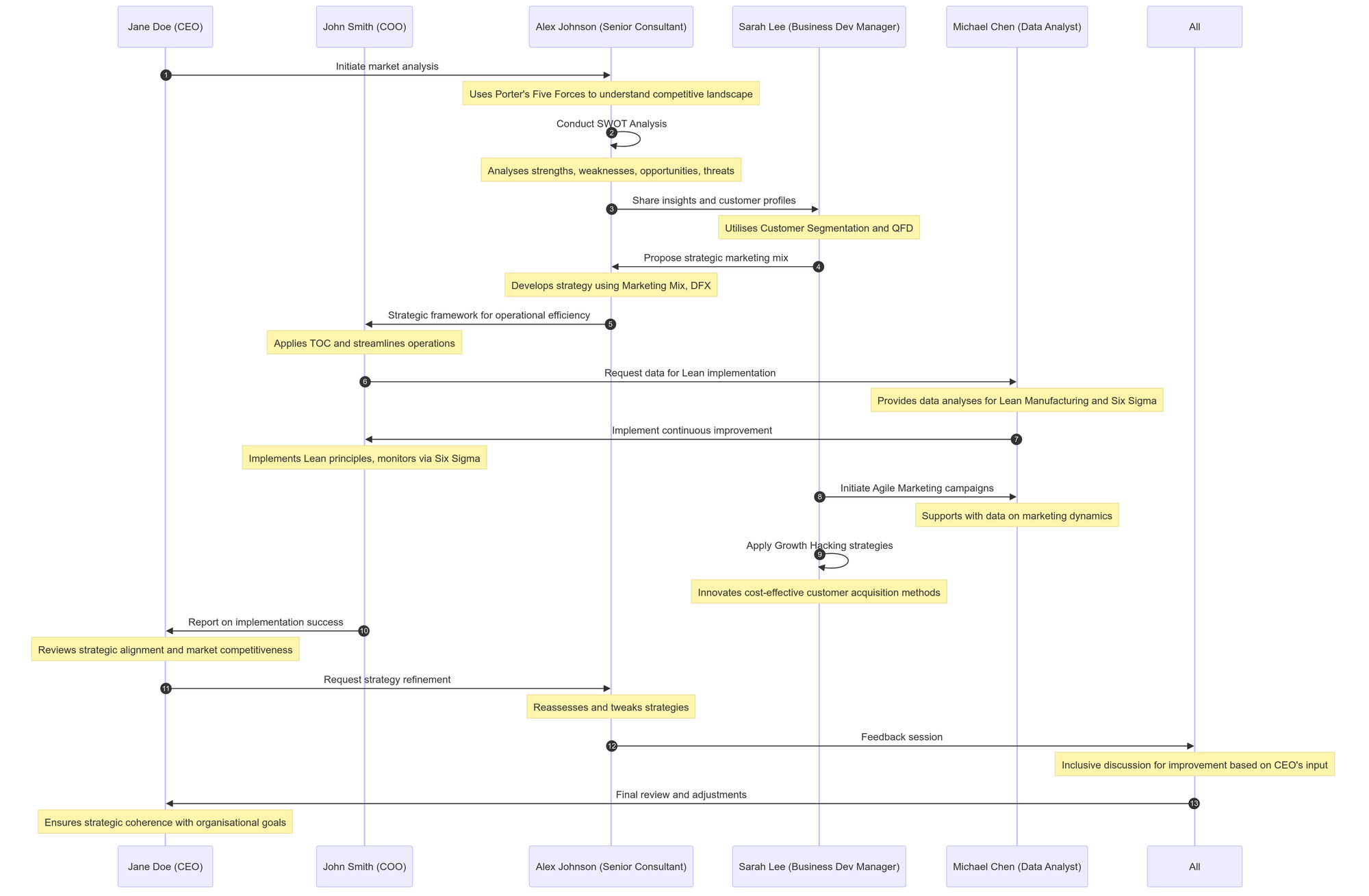
Phase 1: Market Analysis Initiation
Interaction: The CEO, Jane Doe, instructs Senior Consultant Alex Johnson to commence the market analysis.
- Significance: As the strategic job owner, the CEO ensures the alignment of the new initiative with organisational objectives.
- Tool Usage: Leveraging Porter's Five Forces allows a granular understanding of the market dynamics.
Phase 2: Deep Analytical Insights
Interaction: Alex conducts a SWOT analysis to further the insights gained.
- Significance: This phase clarifies internal strengths and external opportunities the firm can capitalise on, essential for informed strategy formulation.
- Tool Usage: The SWOT framework directs focus on tackling weaknesses and threats directly impacting customer acquisition.
Interaction: Alex conveys these insights and delineated customer profiles to Business Development Manager, Sarah Lee.
- Significance: This establishes a foundation for targeted marketing strategies based on detailed customer segmentation and needs.
- Tool Usage: Customer Segmentation and Quality Function Deployment (QFD) are pivotal in translating customer preferences into actionable business metrics.
Phase 3: Strategic Development and Planning
Interaction: Sarah proposes a marketing mix strategy escalated to Alex for refinement.
- Significance: Here, strategic marketing elements are tailored to fit precisely into the identified customer profiles.
- Tool Usage: Marketing Mix combined with Design for X (DFX) ensures products meet specific customer expectations enhancing market entry success.
Interaction: Alex collaborates with COO John Smith to ensure that the strategies are operationally feasible.
- Significance: This phase bridges the strategic intent with operational capabilities, focusing on efficiency and effectiveness.
- Tool Usage: Theory of Constraints (TOC) is utilised here to identify and address any operational bottlenecks.
Phase 4: Execution and Optimisation
Interaction: John requests critical data from Data Analyst Michael Chen for Lean Manufacturing and Six Sigma initiatives.
- Significance: Accurate data is crucial for implementing effective manufacturing and quality control processes.
- Tool Usage: Lean Manufacturing principles and Six Sigma methodologies focus on process optimisation and defect reduction.
Interaction: Sarah engages Michael to provide supporting data for Agile Marketing campaigns.
- Significance: This enables the development of flexible and responsive marketing strategies that can be continually adapted to market feedback.
- Tool Usage: Agile Marketing emphasises rapid iteration and responsiveness, essential for dynamic market environments.
Interaction: Sarah applies Growth Hacking strategies to boost acquisition efforts.
- Significance: Innovative, cost-effective strategies enhance customer engagement without substantial resource expenditure.
- Tool Usage: Growth Hacking focuses on leveraging creative, low-cost strategies to significantly increase customer base.
Phase 5: Review and Refinement
Interaction: John reports the implementation outcomes to Jane.
- Significance: This evaluation determines the success of the operational strategies in achieving the designed objectives.
- Tool Usage: Reviews are crucial for assessing the operational impact of the strategies on market performance.
Interaction: Jane requests a strategy refinement from Alex, based on the outcomes.
- Significance: This ensures that the strategies remain aligned with the company’s strategic vision and market realities.
- Tool Usage: Continuous feedback and strategic realignment are imperative for maintaining relevance in a fluctuating market.
Interaction: A comprehensive feedback session involving all stakeholders is conducted.
- Significance: This encourages collective problem-solving and ownership of the process, promoting a culture of continuous improvement.
- Tool Usage: Feedback mechanisms enable real-time adjustments and foster adaptability.
Interaction: Final adjustments are made following a conclusive review by Jane.
- Tool Usage: Ensures that all strategies and implementations coherently align with overarching business goals.
Through careful planning, strategic alignment, and continuous feedback integration, ManuTech Solutions facilitates a robust customer acquisition strategy.
This comprehensive analytical approach not only aligns with the immediate objectives but also equips the company to adeptly handle future market challenges, driving sustainable growth and competitive advantage in the manufacturing sector.
Tertiary Sector Use Case - Tertiary Sector Business Developers (TSBD)
Organisation Description: TSBD is a fictional organisation focused on providing training and consulting services to businesses in the tertiary sector. Their mission is to help companies improve their customer acquisition strategies by offering tailored toolkits, workshops, and coaching sessions. TSBD's team consists of experienced consultants with diverse backgrounds in various tertiary sectors, ensuring a holistic and industry-specific approach.
Unique Problem Faced: TSBD has identified that many of their clients in the tertiary sector struggle with ineffective customer acquisition strategies. Despite investing significant resources in marketing and sales efforts, these businesses often fail to attract and retain customers, leading to stagnant growth and profitability.
- CEO (Chief Executive Officer) - Jane Smith: As the head of a tertiary sector company, Jane is responsible for the overall strategic direction and financial performance of the organisation. She seeks TSBD's expertise to develop a more effective customer acquisition strategy that will drive growth and increase market share.
- COO (Chief Operating Officer) - Alex Johnson: Alex manages the day-to-day operations of the company and is responsible for implementing the customer acquisition strategy developed in collaboration with TSBD. He will work closely with the TSBD consultants to ensure a smooth execution of the recommended tactics.
- CMO (Chief Marketing Officer) - Sarah Lee: Sarah leads the marketing team and is responsible for planning and executing marketing campaigns. She will collaborate with TSBD to leverage the provided toolkit and optimise the marketing mix for better customer acquisition results.
- CSO (Chief Sales Officer) - David Kim: David oversees the sales team and is responsible for converting leads into customers. He will work closely with TSBD to align sales efforts with the new customer acquisition strategy and improve conversion rates.
- TSBD Lead Consultant - Tom Williams: Tom is an experienced consultant at TSBD, specialising in customer acquisition strategies for the tertiary sector. He will guide the client's team through the toolkit, facilitate workshops, and provide coaching to ensure successful implementation.# Use Case Scenario Approach Strategy for Tertiary Sector Business Developers (TSBD)
Use Case Approach Strategy
Tertiary Sector Business Developers (TSD) is strategically positioned to overhaul and enhance customer acquisition strategies for tertiary sector businesses struggling with stagnant growth. Given the sector's service-oriented nature, TSBD’s approach leverages a specialised toolkit combined with industry-specific auxiliary tools to address inefficiencies and bolster customer engagement and retention.
The core challenge identified is the ineffectiveness of existing customer acquisition strategies within TSBD’s client organisations. This problem typically manifests as disappointing conversion rates and poor customer retention, directly impacting profitability and growth.
- Initiation and Assessment: Engage with client management teams to understand current strategies using Porter’s Five Forces and the SWOT Analysis to assess internal capabilities and market conditions.
- Strategic Development: Develop tailored customer acquisition strategies informed by Customer Segmentation and Customer Journey Mapping. These tools will help pinpoint key customer touchpoints and preferences, aligning offerings more closely with market demand.
- Implementation and Optimisation: Implement the refined strategies using an execution framework that includes Growth Hacking, Agile Marketing, and Marketing Automation tools to enhance adaptability and responsiveness.
- Performance Evaluation and Adjustment: Employ the Balanced Scorecard and AARRR Metrics to measure outcomes and iteratively refine strategies based on feedback and evolving market conditions.
Additional focused improvement will be provided via through Service-Specific Tools:
- Service Blueprinting to visualise and enhance service encounters and touch points.
- Experience Economy principles to transition conventional offerings into memorable service experiences, maximising customer engagement and loyalty.
Toolkit Application Roadmap
Strategy Development
- Porter’s Five Forces & SWOT Analysis: Use these tools to evaluate the competitive landscape and the client's current positioning.
- Customer Segmentation: Identify distinct customer groups to tailor marketing messages and channels effectively.
Strategic Planning
- Customer Journey Mapping & VoC: Map the customer's end-to-end journey to identify critical engagement points and gather actionable customer insights.
- Marketing Mix & Blue Ocean Strategy: Realign the marketing mix while exploring untapped market spaces that offer growth potential without direct competition.
Strategic Execution
- OKRs & Agile Marketing: Implement strategic objectives with agility, allowing for rapid response to market changes.
- Growth Hacking & Marketing Automation: Experiment with innovative, cost-effective marketing tactics and automate repetitive tasks to increase efficiency.
Analysis and Enhancement
- Balanced Scorecard & AARRR Metrics: Monitor varied facets of strategy execution from financial results to customer satisfaction and adjust strategies accordingly.
RACI
| CEO (Jane Smith) | COO (Alex Johnson) | CMO (Sarah Lee) | CSO (David Kim) | TSBD Consultant (Tom Williams) | |
|---|---|---|---|---|---|
| Porter's Five Forces | I | - | C | - | A, R |
| SWOT Analysis | C | - | C | - | A, R |
| Customer Segmentation | - | - | A, R | I | C |
| Customer Journey Mapping | - | - | A, R | I | C |
| Growth Hacking | C | C | C | A, R | I |
Note: A = Accountable, R = Responsible, C = Consulted, I = Informed
MECE Principle
Each toolkit and auxiliary tool has been utilised to ensure the Mutually Exclusive and Collectively Exhaustive (MECE) principle:
- Mutually Exclusive: Tools address distinct aspects without overlap, e.g., customer segmentation distinct from journey mapping.
- Collectively Exhaustive: Together, they address all necessary components of the customer acquisition strategy from analysis to execution and review.

TSBD's use case offers a comprehensive, adaptable model for transforming customer acquisition strategies in the tertiary sector, providing a practical and cutting-edge framework for new management consultants.
Use Case Narrative
The project lifecycle for Tertiary Sector Business Developers (TSBD) is meticulously designed to optimise customer acquisition strategies. Here is an in-depth exploration of each phase, detailing the responsibilities of the involved individuals and the delegation of tasks
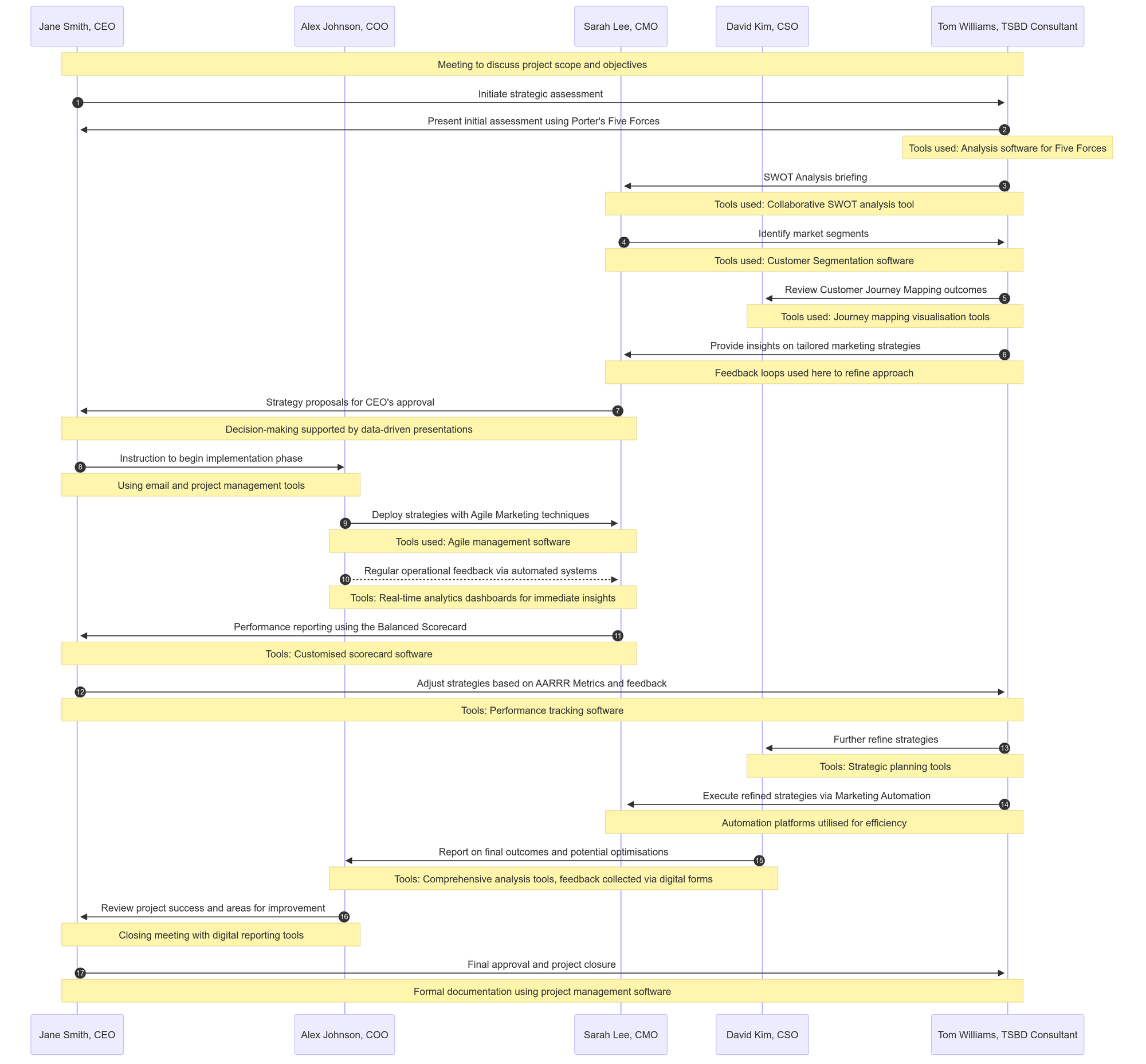
Initial Planning and Strategic Assessment
Jane Smith and Tom Williams Interaction
- Responsibility: Jane initiates and defines the project scope while Tom conducts an initial strategic assessment.
- Tools: Analysis software is used for Porter's Five Forces analysis.
- Impact: This phase establishes a foundation for identifying strategic weaknesses and market opportunities .
Tom Williams and Sarah Lee Interaction
- Responsibility: Tom briefs Sarah on the SWOT analysis, pinpointing strengths, weaknesses, opportunities, and threats.
- Tools: Collaborative SWOT analysis tools facilitate this exchange.
- Delegation and Feedback: Critical insights are derived here which shape the subsequent marketing segmentation efforts .
Sarah Lee's Role in Customer Segmentation
- Responsibility: Lead the customer segmentation process.
- Tools: Specialised software helps identify distinct customer groups, crucial for crafting targeted marketing strategies .
Strategy Development and Decision-Making
Tom Williams and David Kim Interaction
- Responsibility: Tom shares insights from customer journey mapping with David.
- Tools: Visualisation tools help in illustrating customer touchpoints effectively .
Sarah Lee's Strategy Proposals
- Responsibility: Propose detailed marketing strategies based on the initial analyses and customer segmentation.
- Feedback Mechanisms: Modifications to strategies are made based on continuous feedback from Jane, ensuring alignment with overall business goals.
Implementation Directives from Jane Smith to Alex Johnson
- Responsibility: Jane directs Alex to commence the implementation phase.
- Tools: Communication via email and central project management tools ensure clear instructions and record-keeping .
Implementation and Optimisation
Alex Johnson and Sarah Lee Implementation Steps
- Responsibility: Alex oversees the operational execution while Sarah applies agile marketing techniques.
- Tools: Agile management software supports rapid implementation and adaptability .
- Feedback Loop: Real-time feedback via analytics dashboards aids in immediate adjustments and performance improvements .
Reporting and Adjustments by Sarah Lee
- Responsibility: Prepare performance reports using the Balanced Scorecard.
- Tools: Customised reporting software integrates diverse metrics from financial results to customer feedback .
Final Review and Strategy Refinement
Strategy Adjustments and Final Refinements
- Responsibility: Jane and Tom review performance metrics and refine strategies based on AARRR metrics and other feedback.
- Tools: Performance tracking and strategic planning tools facilitate these refinements .
- Outcome: Enhanced strategies are executed using marketing automation tools for increased efficiency and effectiveness .
Final Outcomes and Project Closure
- Responsibility: Alex and David compile the final report detailing the project outcomes and suggest future optimisations.
- Tools: Comprehensive digital tools collect and analyse final data, which is then reviewed in a concluding meeting using advanced reporting tools.
- Process: The project is formally closed by Jane with final approvals, documented using project management software .
Each interaction within this project is crucial, as they collectively drive towards optimising a client’s customer acquisition strategy. The use of specific tools in these interactions ensures efficiency, accuracy, and scalability. Feedback mechanisms are strategically embedded throughout the project phases, allowing for continuous assessment and real-time adjustments. This system ensures that the strategies remain agile and responsive to dynamic market conditions and client needs.
Quaternary Sector Use Case - QuatraTech Innovations
Organisation Description: QuatraTech Innovations is a pioneering company in the quaternary sector, specialising in developing advanced information technology solutions for the agriculture industry. Their product portfolio includes precision farming software, automated irrigation systems, and data-driven crop management tools.
Unique Problem Faced: Despite their innovative offerings, QuatraTech Innovations faces challenges in customer acquisition. Their marketing efforts seem ineffective in reaching the target audience, and the sales team struggles to convert leads into customers. The company needs to refine its customer acquisition strategy to increase market share and drive growth.
- CEO - John Atherton: John is responsible for the overall strategic direction of QuatraTech Innovations. He is keen to improve the customer acquisition strategy and ensure the company's long-term success.
- CMO - Sarah Patel: Sarah leads the marketing team and is accountable for branding, lead generation, and customer engagement. She is determined to optimise marketing efforts and enhance the company's market presence.
- CTO - Michael Lee: Michael oversees the technology department and is responsible for product development and innovation. He aims to align product strategy with customer needs and expectations.
- Head of Sales - David Chen: David manages the sales team and is focused on converting leads into sales. He is eager to implement targeted sales strategies to improve the customer acquisition rate.
- Business Development Consultant - Alex Brown: Alex is a management consultant specialised in business development and customer acquisition. He will use the Management Consultant Toolkit: Business Development - Customer Acquisition Strategy Ineffectiveness to assess QuatraTech Innovations' situation and provide recommendations for improvement.# Use Case Scenario Approach Strategy for QuatraTech Innovations
Use Case Approach Strategy
QuatraTech Innovations, a leader in the quaternary sector focusing on advanced IT solutions for agriculture, is grappling with customer acquisition challenges.
Despite having innovative products like precision farming software and automated irrigation systems, their marketing and sales efforts are failing to achieve desired outcomes. The task is to refine their customer acquisition strategy to bolster market share and foster growth.
To address this, we must employ a comprehensive approach leveraging the Management Consultant Toolkit alongside industry-specific auxiliary tools tailored to the Information Technology and Agriculture sectors.
Toolkit Application Roadmap
Strategy Development
- Begin by deploying Porter's Five Forces and complement it with PESTEL Analysis to assess external market forces and industry competitiveness.
- Conduct a SWOT Analysis to internally evaluate QuatraTech’s strengths, weaknesses, opportunities, and threats.
- Utilise Customer Segmentation and Technology Adoption Lifecycle from the IT Auxiliary Toolkit to understand various customer groups and their technology adoption behaviors.
- Initiate Customer Journey Mapping and integrate Service Blueprinting to visualise the customer experience thoroughly from discovery through to purchase, identifying critical touchpoints for enhancement.
Strategic Planning
- Develop a Positioning Map informed by insights from Vertical Integration analysis to determine QuatraTech’s unique value proposition.
- Plan a comprehensive Marketing Mix (4Ps), considering Open Innovation strategies to leverage external ideas and improve product offerings.
- Implement Blue Ocean Strategy to explore untapped market spaces, creating new demand and reducing competition relevance.
- Employ AARRR (Pirate Metrics) for measuring and optimising the customer lifecycle stages, enhancing each touchpoint effectively.
Strategic Execution
- In the execution phase, start with the Balanced Scorecard alongside Precision Agriculture techniques to monitor performance across various business perspectives.
- Set and track ambitious goals using OKR (Objectives and Key Results), ensuring alignment with strategic business objectives.
- Promote Agile Marketing methodologies to allow for iterative campaign modifications based on real-time data.
- Apply Growth Hacking and Marketing Automation techniques to discover scalable and cost-effective customer acquisition strategies.
RACI
| Tool | CEO (John Atherton) | CMO (Sarah Patel) | CTO (Michael Lee) | Head of Sales (David Chen) | Consultant (Alex Brown) |
|---|---|---|---|---|---|
| Porter's Five Forces | A | C | I | R | S |
| SWOT Analysis | R | S | I | I | A |
| Customer Segmentation | I | A | R | C | S |
| Customer Journey Mapping | I | S | I | A | R |
| Marketing Mix (4Ps) | C | A | I | S | R |
Legend: R - Responsible, A - Accountable, C - Consulted, I - Informed, S - Support
MECE Principle
The approach ensures that the tools used do not overlap functionally (Mutually Exclusive) and collectively cover all necessary aspects of the strategy (Collectively Exhaustive).

This pathway effectively bridges strategic assessments to actionable insights, ensuring no critical aspects are omitted and each step informs the subsequent one directly. The use of both primary and information technology-specific strategies adds a layer of specificity ideal for QuatraTech's business context.
Use Case Narrative
The sequence diagram outlines the main project interactions.
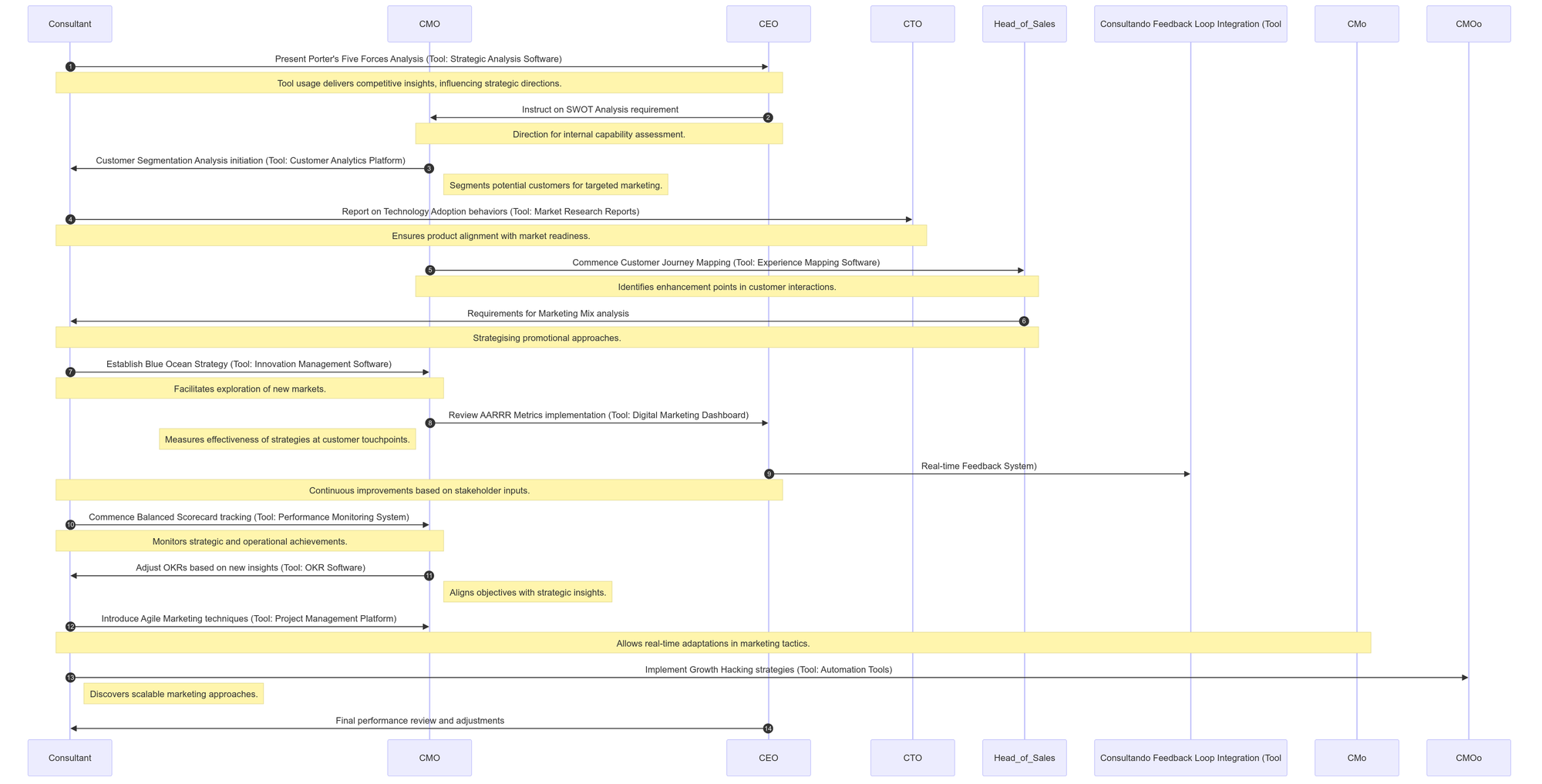
Strategic Description Phase
- Porter's Five Forces Analysis
- Responsibility: Consultant supports with analysis tools.
- Interaction: Consultant presents the results to the CEO (1).
- Tool Significance: Strategic Analysis Software facilitates the gathering of market competitiveness and potential inhibitors to QuatraTech’s growth.
- Feedback Mechanism: Continuous competitor monitoring ensures that the strategy adapates to the market dynamics.
- SWOT Analysis
- Responsibility: CMO conducts the analysis, with the Consultant providing a supportive role (2).
- Interaction: CEO instructs CMO to outline internal strengths and weaknesses juxtaposed with external opportunities and threats.
- Feedback Contribution: Findings help tailor future strategic decisions, ensuring they are informed by both capabilities and market conditions.
- Customer Segmentation and Technology Adoption Lifecycle
- Responsibility: Consultant compiles and analyses market data; CTO and Head of Sales provide industry insights (3, 4).
- Interaction: This segment identifies specific customer bases for targeted marketing strategies and assesses their readiness for technology adoption.
- Tool Usage: Customer Analytics and Market Research reports yield detailed demographic and behavioral data.
Strategic Planning Phase
- Customer Journey Mapping
- Responsibility: Head of Sales leads this initiative, with directive support from the CMO (5).
- Interaction: Mapping out the customer's journey from awareness to purchase, focusing on enhancing touchpoints.
- Tool Usage: Experience Mapping Software visually outlines the journey, highlighting areas needing improvement.
- Marketing Mix (4Ps)
- Responsibility: Consultant advises on the optimal blend of Product, Price, Place, Promotion (6).
- Interaction: Discussions oriented around structuring marketing strategies that resonate with identified customer segments.
- Blue Ocean Strategy and AARRR Metrics
- Responsiveness: CMO deploys strategies to find untapped markets while regularly reviewing metrics to gauge success (7, 8).
- Interactions: Consultant facilitates strategy sessions using innovation management tools, and CMO monitors through digital dashboards.
Strategic Execution Phase
- Balanced Scorecard and OKR Integration
- Responsibilities: Consultant sets the framework for performance tracking and objective setting supported by real-time feedback and adjustments (9, 10).
- Interactions: Regular reviews of strategic and operational KPIs ensure alignment with long-term goals.
- Agile Marketing and Growth Hacking
- Responsible: Consultant and CMO iterate marketing strategies based on data-driven insights (11, 12).
- Interaction: Use of project management and automation tools help refine marketing efforts to be more adaptive and impact-focused.
Final Review and Adjustment
- Responsibility: CEO and consultant evaluate overall project effectiveness, consider stakeholder feedback, and make final adjustments (13).
- Interactions: This phase ensures that the strategic implementations have been effective and aligned with the initial objectives, adjusting as necessary based on performance data.
Throughout the project, strategic decisions are data-driven and continuously iterated upon with stakeholder input. This dynamic and responsive approach ensures QuatraTech not only understands its market better but also ad0pts effectively to ensure maximum impact in its customer acquisition efforts.
Comparative Analysis for Toolkit Effectiveness
The following table presents a detailed comparative analysis of tools from the Management Consultant Toolkit across various industry sectors. Each tool has been evaluated based on its strengths, weaknesses, and overall usefulness in addressing the specific challenges related to customer acquisition strategy ineffectiveness within different industry contexts.
| Tool Name | Industry Sector | Tool Strengths | Tool Weaknesses | Usefulness |
|---|---|---|---|---|
| Porter's Five Forces | Primary | Provides in-depth analysis of competitive forces and market dynamics. | May overlook non-market forces like regulatory impacts. | 4 |
| SWOT Analysis | Primary | Identifies internal and external factors influencing the strategy's effectiveness. | May provide a static picture, missing dynamic market changes. | 3 |
| Customer Segmentation | Primary | Enhances focus on targeting and marketing efforts. | Requires detailed and often hard-to-acquire data on potential customers. | 5 |
| Customer Journey Mapping | Primary | Identifies gaps in the customer experience. | Time-consuming and may require frequent updates as customer behavior changes. | 4 |
| Voice of the Customer (VoC) | Primary | Direct feedback aids in improving products/services. | Collecting and analysing feedback can be resource-intensive. | 4 |
| Positioning Map | Secondary | Helps visualise market positions relative to competitors. | May oversimplify market dynamics, missing subtle nuances. | 3 |
| Marketing Mix (4Ps) | Secondary | Well-rounded tool for adjusting marketing strategies across multiple dimensions. | Doesn't account for customer interaction after the purchase, which can be crucial. | 4 |
| Blue Ocean Strategy | Secondary | Encourages innovation by shifting focus from competition. | Risky as it involves making business moves untested by competitors. | 4 |
| AARRR Metrics | Secondary | Effective in tracking customer lifecycle stages. | Requires sophisticated tracking systems and integration across platforms. | 5 |
| Customer Lifetime Value (CLV) | Secondary | Helps focus on long-term profitability per customer. | Complex to calculate accurately without detailed historical data. | 3 |
| Balanced Scorecard | Tertiary | Integrates multiple perspectives including customer insight. | Implementing it across various departments can be challenging due to differing needs and expectations. | 4 |
| OKRs | Tertiary | Aligns company efforts towards common ambitious goals. | Can lead to overemphasis on measurable results, potentially neglecting important qualitative goals. | 4 |
| Agile Marketing | Tertiary | Allows real-time campaign modifications based on latest data and feedback. | May lead to short-term focus, missing longer strategic goals unless carefully balanced. | 5 |
| Growth Hacking | Quaternary | Low-cost, innovation-driven marketing techniques; ideal for startups. | May not be scalable or suitable for larger, more established companies looking for sustainable growth. | 4 |
| Marketing Automation | Quaternary | Streamlines marketing processes, improves customer communication efficiency. | High initial setup cost and complexity, possibly leading to a steep learning curve. | 5 |
Insights Derived from Comparative Table
The toolkit's application shows significant differences in its effectiveness across different industry sectors. Customer Segmentation and Agile Marketing rank high in usefulness across all sectors, highlighting their universal applicability and impact in addressing customer acquisition-related challenges. These tools help organisations target their marketing efforts more precisely and adapt to market needs in real-time, which is crucial for maintaining competitive edge.
In contrast, SWOT Analysis, while being a fundamental strategic tool, shows a lower usefulness score in dynamic market conditions where constant updates and flexibility in strategy are required. Similarly, Positioning Map also demonstrates limitations in complex markets where multiple variables influence success beyond simple competitive positioning.
Variance in Usage Between Sectors
- Primary Sector: Tools like Customer Journey Mapping and VoC are particularly effective as businesses in this sector often deal directly with end consumers whose preferences and feedback can significantly impact product development and marketing strategies.
- Secondary Sector: AARRR Metrics and Marketing Mix are more useful as they allow businesses to track detailed customer behaviours and adjust the 4Ps — Product, Price, Place, and Promotion — based on solid data.
- Tertiary Sector: Emphasises on Balanced Scorecard and OKRs, tools that integrate customer feedback into performance metrics, aligning operational outputs with strategic business goals.
- Quaternary Sector: Leverages technology-driven tools like Growth Hacking and Marketing Automation which suits the innovation-centric nature of this sector focusing on information services and technology-based solutions.
Conclusion
From Porter’s Five Forces in the primary sector to Marketing Automation in the quaternary sector, the strategic application of specific tools significantly strengthens customer acquisition strategies.
This analysis not only highlights the most effective tools per sector but also underscores the necessity of tailoring strategies to fit the unique challenges and opportunities presented by each market segment.
As industries continue to evolve, so too must the tools and strategies we employ. The insights gained from this analysis serve not just as a guideline but as a strategic framework for businesses aiming to optimise their customer acquisition efforts and ensure long-term viability and success in their respective markets.
Call to Action
We encourage business leaders and strategists to reflect on these insights and consider how they might be applied to enhance their own customer acquisition strategies.
For more detailed guidance or to explore partnership opportunities in implementing these tools and strategies, reaching out to management consulting professionals can provide tailored solutions that drive significant business growth.
